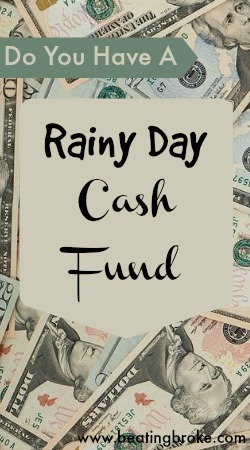Everyone should have a rainy day cash fund. Not an emergency fund. Although, you should have one of those as well. No, a rainy day cash fund should be exactly that. Cash. Easily accessible, and easily spendable. Ahhh! Did he just say “easily spendable”? Yes. I did. Why would I say something like that? Common advice is that you should put your money in an account where it isn’t easily spendable. Especially your emergency fund. You don’t want any everyday “emergency” to drain your emergency fund dry. It’s for real emergencies. An engine in a car that stops working and needs repairs. Although, some would argue that’s what a car repair fund is for. Those quasi “emergencies” aren’t what a rainy day cash fund is for either. Sorry. I’m sure some of you wanted me to tell you that it was smart to have a little stash of cash that you could hide away for those tools you really, really, “needed”. But, it’s not for that.
What is a Rainy Day Cash Fund for?

How Much Cash in a Rainy Day Cash Fund?
Thousands. Then, please send me a note with your address, and the exact location where the cash is stored. I’m only kidding. Much like anything else, your rainy day cash fund is a bit variable. It will depend on what you can afford to just put away in cash. Although, for most, the rainy day cash fund is well within budgetary limits. Really, what we’re talking about is having enough cash available that you can afford a tank of gas, or a loaf of bread should you be unable to use a debit card. In almost every case, something like $100 should be plenty.
Where to Put the Rainy Day Cash Fund?
The short answer is, wherever you want. Just make sure that it’s reasonably secure, and easily accessible. Buried in a can in the back yard is probably not the best idea. Your wallet isn’t a very good idea either. If you’re creative enough, you can find plenty of places to hide that small stash in your house. If you’re not so creative, there are plenty of pre-devised ways to stealthily hide your money. Here’s a few easy ones:
- Tape the bills lightly (you don’t want to rip them taking them off) to the back of a framed picture in your house. Most people won’t look there, and you’ve only got to take the picture off the wall to reach them. Just don’t forget they’re there if you decide you don’t want the picture anymore.
- Under your mattress. Yes, really. It’s an old joke, but it’s also a convenient place that’s easily reachable and that most people aren’t going to casually look in if they’re being nosy.
- In a book. Pick your favorite book, and your favorite page and place the bills in the books there. Again, easily reachable, and less likely to be found. Just make sure that if you ever decide that you don’t need that book around, that you take the money out first.
- In the freezer. This is another old one. Throw the bills into an envelope and place it at the back of the freezer. Easy enough to get to if you really, really need it, but not so easy that guests (welcome or not) will easily find it.
- Behind the furnace. Put the bills in an envelope, along with a decently strong kitchen magnet. Attach the envelope to the back of your furnace or any metal surfaced appliance so long as they won’t be exposed to flame or extreme heat. Easily accessible, but who’s gonna go poking around your furnace (or the back of your fridge) looking for loot?
That’s just a few ideas. What it really boils down to is putting a little cash away for a rainy day when you need it, and placing it somewhere where it won’t easily be found by prying eyes. What do you think? Should you have a little rainy day cash fund? How much would you put in it? Where are some other good places to put the cash?

I started this blog to share what I know and what I was learning about personal finance. Along the way I’ve met and found many blogging friends. Please feel free to connect with me on the Beating Broke accounts: Twitter and Facebook.
You can also connect with me personally at Novelnaut, Thatedeguy, Shane Ede, and my personal Twitter.

I have over $10k in cash just in case I ever need it, but I’m planning to only ever use any for a future home down payment. But I guess that is why it is a rainy day fund, if I had plans for the cash, it would just be savings.
We’ve got a couple hundred bucks stashed in the house but nothing outrageous.
I never thought to do this. My husband and I have money set aside if something happens but not cash. I will talk to him about this. Thanks!
I have a couple of thousand dollars locked in my gun safe. Not the best option, since thieves look there, but generally ok.
Before, I hid my money inside my cabinet and forget about it, I was just so silly for doing that. One day I was just shocked when I saw some money in my pants and my husband’s t-shirt.
I don’t have actual cash hanging around. It’s a good idea, but I just haven’t really thought much about it. That would probably come in handy in case the ATMs and credit card machines went down…maybe I will have to keep some cash savings in the house. Hmmm.
I had never thought about needing cash physically on hand in the sort of situation you describe. I had a neighbor who seemed to have cash stuffed away all over their house and it seemed crazy to me. Maybe crazy in a genius kind of way??
We used to keep $100 for the reasons you’ve mentions, but we haven’t replenished after using it a while back. It’s a great reminder that we need to get back to doing this!
We started doing this years ago because we do randomly go on trips and have expenses that we pay in cash like our biweekly housekeeper and lawn guy. So we keep around $1000 in cash…it fluctuates between $500-$3000 as rent money comes in and we pay the cash expenses, BUT $1000-ish is where we try to keep it. It did come in handy when hurricane Ike took out our power for 9 days. We were able to buy groceries and gas and even covered a little gas for a cashless neighbor until the power came back.
I am in my early 50s
And started putting money away
Like $296 a month
How much will i have in 10 yr?
Hi Donny,
It really depends on where you’re putting your money. If you’re just stuffing it under the mattress, you’ll have $296x12x10 = $35520. Obviously, that’s probably not where you’re putting it. At 50, you should be putting that money into something like a ROTH IRA or another tax sheltered retirement account if you have one available to you through work.